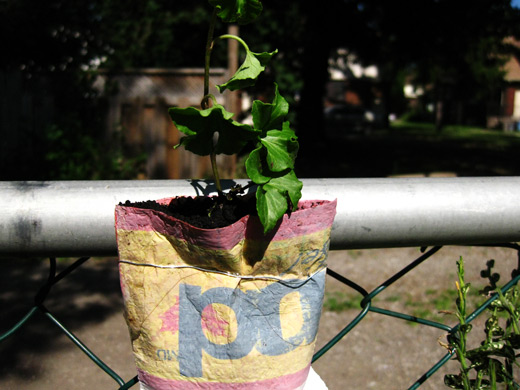
We’re doing some field tests of our magnetic planters with some plants in them. Basically, we want to test to make sure the soil isn’t drying out too quickly and we’re also checking to see how well some plants respond to transplants. Above, you can see there’s a wire around the planter that helps it to keep its shape—some of the planters without a wide edge on either side are more prone to open up really wide at the top, which makes it difficult for the soil to fill the planter uniformly. Without it, the soil eventually sinks and adding any more soil would risk making the planter too heavy for the magnet.
Michelle’s running these tests, checking on the plants daily and testing a few varieties of planter shapes in preparation of the installation of all of our planters sometime in the next week or so.

Hey this is a brilliant idea!
The town where I live is quickly being closed in with 7ft tall cyclone wire fences!
It is a tropical city and we have a plant known as The Banyan Fig. This fig grows aerial roots and is known to begin it’s life from seeds dropped in high places by birds.
These would make the ideal plant for your magnetic planters. The fig is quite invasive but is also regarded as a sacred tree in Bali and a tree of knowledge and learning here in Australia.
Imagine a disused lot suddenly sprouting a wall of Banyan figs!
I believe adding sponge bits would keep water longer and keep the weight down. Using a stiff density sponge could also give you support for the planter as well, if cut in a circular shape.
David, thanks for the note. I think if we end up doing another iteration of this project next spring, it’d be good to find some plants that, while not invasive, might work to climb over a fence, or encourage some other type of movement… maybe something like wild raspberries or something else with seeds?
Richard, adding sponges could be a great idea. Given the size of the planters though, I’m not sure what we could fit in there and still have enough soil for the plants to root. That being said, maybe even a small layer of dense sponge at the bottom could be the bit of help that the need. Looking at the test planters though, the one pictured above had a pretty basic dirt in it and it’s holding the water much better than the planter with the soil transplanted. Definitely something to continue to experiment with!